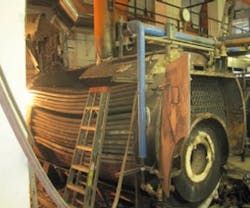Steam System Maintenance: Avoid Losses and Injuries
Most people in management do not think daily about maintenance. When money is tight, maintenance is one of the first budget items to cut. But in attempting to save money, many facilities experience larger losses in other budgets due to the consequences of deferred maintenance.
We will build a business case for maintenance based on energy savings as well as avoidance of losses and personal injuries.
Example #1: Boiler Failure
Boilers systems are highly dependent on maintenance for safety, asset protection and energy efficiency. In my experience with boiler surveys, nearly all boilers are throwing away some money – we need only determine how much.
Below (Photo1) is an extreme example of a failed maintenance program. The consequences of several unnoticed system failures allowed the boiler to fire without water in it. With no place for the energy to go, the boiler melted. It warped the exchanger tubes – even the thicker parts of the steel. The boiler was severely damaged, resulting in major downtime, a costly replacement, and a big hit on the organization’s cash flow.
It is worth noting that when such unexpected failures occur, it can be at the worst possible time. In another facility during one of the winter’s coldest days, we had to ask management to shut down a boiler due to safety reasons and risk of explosion. The client was worried that the plumbing would freeze, causing even more damage. Fortunately, that did not occur but the boiler shutoff could not be avoided.
A proper maintenance program, inspections and personnel training minimize such failures and are required in many areas. When deferred maintenance results in a violation of the law or code, the legal liability alone from an accident can dwarf the cost of the maintenance budget.
Example #2: Steam System Failure
Another example of maintenance failure involved a large campus steam system with miles of distribution piping. The steam system consumed over $4 million per year in natural gas to fire the boilers in a central plant supplying 100 psi steam. For many years, there had been maintenance personnel dedicated to finding and repairing steam leaks in the piping. During that time, the system was reasonably healthy and had good condensate return flow.
A few years ago, a middle manager looking for a budget cut eliminated the leak repairman position, which resulted in an immediate savings of $100,000 per year in labor and material.
However, after the first year, leaks began to accumulate – and they went unnoticed and unrepaired. As you can see from the table below, the cost of just one 1/8-inch steam leak at 100 psig is about $3,800 annually at $10/MCF. After two years, the steam leaks were noticeable throughout the plant. The energy impact on the fuel bill showed up in a different budget. No one in management understood that about $500,000 was being lost annually in additional costs for water, sewer and chemical costs. Thus, the original cost-cutting action had become a $400,000 net loss.
Table 1. Cost of Steam Leaks (Source: DOE Best Practices Steam End User Training 2010)
The Domino Effect of Maintenance
The negative impacts at the facility exceeded the $400,000 because the many visible leaks gave employees the impression that management didn’t really care about waste or possible injury to employees.
Photo 3 shows an obvious steam leak that could easily be repaired, but was instead visible to employees for years. Morale suffered and employees mentally gave up on repairing many systems, which reduced the overall quality of manufacturing at the site. This lack of attention to detail contributed to a site-wide dysfunctional culture and even affected the contractors who serviced the site, whose work ethic also declined because they felt no one was checking their work.
Fixing steam leaks usually has a return on investment of around 150% – better than the profit margin of many companies. Be sure to point that out to your management if your maintenance budget is threatened.
Special thanks to Asit Patel for his contribution about the melted boiler to this article. Asit can be reached at [email protected] or 516-492-4577.
If you have a case study you would like to share, please send it to [email protected].
---------------------------------------------------------
